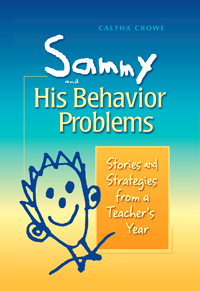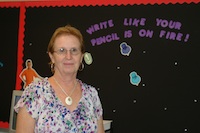Solving Behavior Problems
Sammy and His Behavior Problems
by Caltha Crowe
(Responsive Education, 2010 – Learn more)
Every teacher has a “Sammy” in their class. He is the student that may drain the energy from you and the rest of the classroom. He‘s the kid that “plucks at your heartstrings” but just seems to leave you exhausted. He’s the kid who tries so hard to make friends, but each time he finds one, he wears out the friendship before it has a chance to develop.
Sammy and His Behavior Problems by Caltha Crowe is a remarkable book that reaches into the heart of every teacher. It is written as a narrative, including personal reflections in the form of journal entries and anecdotes about daily interactions in the classroom. Through her narratives we see what is happening in Ms. Crowe’s classroom as Sammy interacts with other students and other staff members.

Sammy’s story
The narrative begins on the first day of school when we meet Sammy, an impulsive third grader who is “passionate about history,” tells corny jokes and whose only hope is to “maybe make friends.”
As you read Crowe’s entries, it’s easy to feel a deep connection as she shares her reflections, inquiries, frustrations, and triumphs in working with Sammy. We learn the ways that she worked with Sammy to ensure that he and all the students in the class had a successful third grade experience.
Sammy’s story is divided into four sections, one for each part of the school year: Beginnings, Settling In, Growth in the New Year, and the End of the Year. As I read the book, I felt as if I was having a conversation with Caltha Crowe. Each time I wondered about something, I found that she’d anticipated my questions and answered them in the next paragraph.
Helpful advice from a teacher colleague
Although the book focuses mainly on her relationship with Sammy, the strategies that she shares can be applied to any classroom and to other grade levels. Through her stories, we are reminded of the importance of building classroom community and recognizing each child’s strengths, weaknesses, and personality.
Crowe talks to the reader and not at the reader. In her journal entries, she honestly shares her emotions, raises questions about what she observes in the classroom, and outlines the strategies she plans to use. She willingly shares her frustrations such as an eraser incident that occurred when Sammy decided to draw “Leonardo” faces on erasers which were intended for the standardized tests. “I need to take a deep breath here and think about what is most important (the children, not the erasers) and what is going well.”
Every day with Sammy is a power struggle, as it is with many of the students in our classrooms. Their negative behavior seems to outweigh their attempts to correct the behavior. Her stories about Sammy reminded me of students I have taught and similar struggles that I have heard about from colleagues.
The value of reflection
Crowe does what I promise to do every year — take time each day to reflect, write in my journal, and prepare better anecdotal records that I can use to drive my teaching. She reminds us that it is essential to take the time to reflect on your teaching and not just on lesson planning. Often we become encumbered worrying whether we will finish the math book by June and forget to take time to keep a journal which chronicles our successes and areas we are concerned about.
Although the main focus of the book is not about keeping a professorial journal, Caltha Crowe’s entries remind us of the importance of taking the time to be honest with yourself, to identify measurable goals that meet the academic, social and emotional need of our students, and to celebrate our daily successes in the classroom.
I loved this book because it reminded me that teaching academic subjects is not just a job for me but a true passion I have that matches my desire to make an impact on every student’s life. It also reminds me to take time now and again to reflect on the mission statement that I hang up in my classroom every year:
My mission as your child’s teacher is to develop and maintain a learning environment that encourages all students to develop their talents to their fullest. In my classroom, I will continue to foster the development of a positive self-esteem and a lifelong love of learning. I want my students to feel secure in an environment which encourages children to be creative, to take educational risks, to challenge their potential, and be responsible learners. I will provide each student with educational, emotional, and social experiences that are designed to help them believe in themselves, develop their true potential, and reach their goals.
Linda Biondi is a fifth grade teacher at Pond Road Middle School in Robbinsville, New Jersey. She has written for Education World, the Responsive Classroom newsletter, and the ERIC Clearinghouse. She’s also the recipient of several grants that promote inquiry and a literacy enriched curriculum, and a consultant with the National Writing Project
.




































